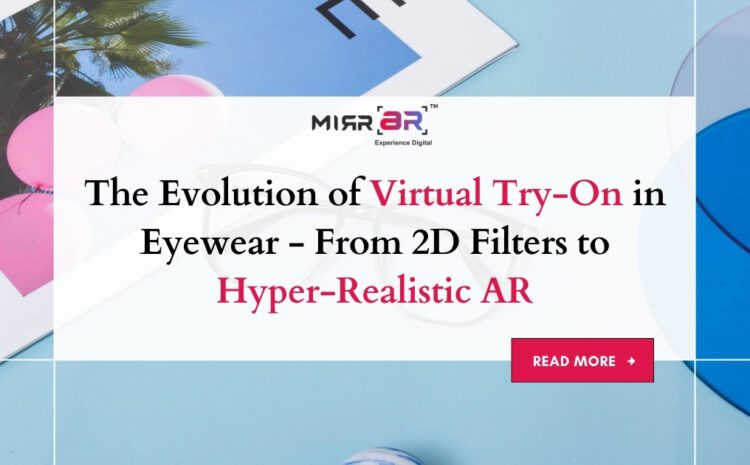In the digital age, the shopping experience is undergoing a revolutionary transformation—and eyewear is at the forefront of this shift. The rise of virtual try-on (VTO) technology has redefined how consumers interact with products online, moving from rudimentary 2D filters to sophisticated, hyper-realistic augmented reality (AR) experiences. For the eyewear industry, this evolution has not only elevated the user experience but has also significantly boosted sales, engagement, and consumer confidence.
The Beginnings: 2D Filters and Static Overlays
The early stages of virtual try-on technology in eyewear were basic yet groundbreaking for their time. These systems typically used static images or 2D filters overlaid on a user’s photo or live camera feed. While it offered a basic preview of how glasses might look on a person, it lacked depth, realism, and facial tracking accuracy.
Consumers could select frames, upload a selfie, and get a rough idea of how they’d appear. However, the absence of real-time feedback and limited customization made these early tools feel gimmicky rather than practical. Despite their limitations, 2D VTO solutions laid the foundation for innovation and consumer acceptance of digital try-ons.
The Leap to 3D and Augmented Reality
The introduction of 3D modeling and AR brought the next wave of disruption. Unlike 2D filters, AR-based VTO tools could map the user’s facial features with incredible precision, enabling real-time interaction. This meant glasses no longer just sat on top of an image—they moved, scaled, and aligned with the user’s head and face movements in real time.
Facial landmark recognition, AI-powered depth detection, and device camera improvements helped create immersive VTO experiences that accurately represented frame fit, size, and even lens tint. This realism dramatically improved consumer confidence in their purchase decisions, reducing return rates and increasing conversion.
Hyper-Realism and AI Integration
Today’s virtual try-on technology for eyewear is achieving hyper-realism thanks to the integration of AI, computer vision, and high-definition rendering. Modern VTO platforms can analyze skin tones, lighting conditions, facial geometry, and more to provide a realistic and personalized shopping experience.
Luxury and high-end eyewear brands are increasingly turning to tools like MirrAR, which delivers advanced AR-based try-on capabilities. MirrAR not only showcases accurate sizing and positioning of eyewear but also offers subtle details like reflections on lenses, material textures, and dynamic lighting—ensuring the product looks and feels as real as possible on screen.
With AI-powered recommendation engines, users also receive suggestions tailored to their face shape, lifestyle, and preferences, mimicking the personalized assistance typically offered in a physical store.
E-Commerce Meets Experience
In the current landscape, e-commerce is no longer just about convenience—it’s about creating memorable experiences. Virtual try-on technology for eyewear now provides a blend of both, empowering customers to explore a variety of frames from the comfort of their homes while receiving the same level of personalization they’d get in-store.
Brands leveraging advanced VTO have reported significant spikes in engagement. Consumers spend more time browsing, trying multiple frames, and sharing images or videos with friends and family before making a purchase—turning shopping into a social and interactive experience.
Moreover, omnichannel retailers now integrate VTO tools in-store using smart mirrors and tablets, bridging the gap between digital and physical retail.
The Sustainability Edge
Besides enhancing the user experience, VTO in eyewear also supports sustainability. It reduces the need for sample stock, packaging, and shipping, especially in the trial phase. By cutting down on product returns and minimizing waste, virtual try-on contributes to a more responsible and environmentally-friendly retail model.
Luxury eyewear brands, in particular, benefit from aligning VTO with their sustainability goals, offering tech-savvy and eco-conscious consumers an innovative and ethical shopping experience.
The Road Ahead: What’s Next?
As we look to the future, the evolution of VTO in eyewear will likely move toward even deeper personalization and more immersive technologies. With the advent of haptic feedback, virtual avatars, and digital twins, users might soon be able to not just see but feel how the frame sits on their nose or behind their ears.
Integration with the metaverse may allow shoppers to try on glasses in virtual environments, attend fashion shows with their digital avatars, or even consult AI-powered stylists—all within a single platform.
We can also expect improved accessibility features, allowing users with vision impairments or unique facial structures to find eyewear tailored specifically for their needs.
Conclusion
From pixelated 2D filters to immersive AR experiences, the journey of virtual try-on technology in the eyewear industry reflects how innovation can reshape consumer expectations. As hyper-realistic, AI-integrated tools like MirrAR continue to lead the way, brands that embrace this evolution stand to gain not just in sales—but in customer loyalty, brand trust, and long-term market relevance.
For consumers, the ability to virtually try on eyewear brings unmatched convenience, confidence, and personalization—proving that the future of fashion, even in something as functional as glasses, lies at the intersection of technology and experience.
